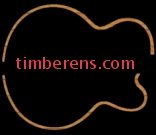
|
Developing Your Ears |
![]()
Every good musician has good ears. Having good ears is as fundamental to a musician as having good legs is to a basketball player.
A very small percentage of people are simply born with good ears. They have a gift known as "perfect pitch" which means they can hear a pitch and know exactly which note the pitch is.
Most of us do not have perfect pitch, so we must work to develop our ears. Our ears must be trained to hear just like our fingers must be trained to play.
The first step toward developing good ears is to be able to recognize the scale step of any given note in a melody. You should learn to hear a note, and immediately know if it is the root, 2nd, 3rd, 4th, etc. of its tonic scale.
You need not know the name of the note. In fact, unless you have perfect pitch, you probably will not know the name of the note by ear alone. But you should learn to hear a note and recognize its position in the scale.
For example, play a C chord on the guitar (even better is to do this on piano). Then play the notes in a C scale: C D E F G A B C. Play the C chord in between each of the notes, and listen to how each one of them sounds against the C chord. They all have a distinct sound; each step of the scale tugs against and blends with the tonic in a unique way.
Work on learning to recognize the scale step by having a friend play a C chord, then a random note from the C scale. After a while, it will become automatic -- you will learn to recognize each scale step just like you recognize a friend's face.
When you are comfortable with recognizing the steps of a major scale, begin work on the minor scales. Then begin work on all the notes in between the notes of the scale. You will eventually recognize a flat 5 just as easily as you recognize the third.
After you have learned the basics, you can then make use of all the tunes you already know from our culture -- TV themes, Christmas tunes, folk melodies, simple pop tunes, that sort of thing. We all know hundreds, perhaps thousands of these simple melodies.
All day long, when you have a few unused brain cycles, such as when standing in line or driving your car, think of a simple tune you know, and picture what the melody looks and feels and sounds like. Then work out how the melody would be played in some non-specific key. Think of the scale steps of each note in the melody. Sing or whistle the melody to yourself. Try to imagine each note's relationship to the tonic - or its relative position in the scale.
The key you think in is unimportant, but if you want to give it a key, think in the key of C.
For a very simple example, let's think of Row Row Row Your Boat. It is:
1
1 1
2 3 3
2 3 4 5
Row row row your boat gent-ly down the stream
8 8 5
5 3 3 1 1
Merri-ly Merri-ly Merri-ly Merri-ly
5 4 3 2 1
Life is but a dream
At first, it may be easier for you to think of a piano keyboard as you do this. If you do, just always think in the key of C.
As you picture the relationships of the notes, imagine playing them on the guitar. Picture your fingers on the fret board in a familiar scale form as you sing the melody to yourself. Don't try to actually play it on guitar until you have fully worked it out in your head. Then sit down and play it. If you have worked it out properly, you will be able to play it "by ear" the very first time you try to play it.
Do this with dozens, hundreds of songs. Do this every day throughout your day whenever you are bored. It will become a new hobby for you. It will help you pass the time while standing in line and the awful Muzak radio is playing "Like a Rhinestone Cowboy". (5 5 1 2 3 5)
You will develop great ears and it will feel effortless because you won't have to devote valuable time to it -- you will be just making good use of time that is otherwise wasted.
After a while, which really might be months or even a couple years (nobody ever said playing music is easy even though it's fun), you'll develop a sort of "map" in your mind between your knowledge of theory, your sense of pitch, and your fingers. Each component of the map will help reinforce the other components.
I know this seems confusing, and it will take a while at first, but then all the sudden it will click. You'll be able to hear more and more complex melodies.
Make sure you start out with very simple little melodies - Pop Goes the Weasel, Old McDonald, Jingle Bells -- that sort of tune. It's unlikely that you'll be able to jump straight into hearing bebop lines if you are unable to hear Oh When the Saints Go Marching In.
Happy listening.
© 2002 - 2016, Tim Berens
All rights reserved